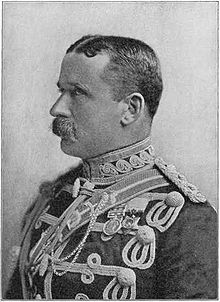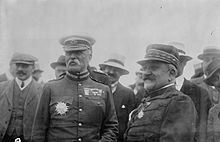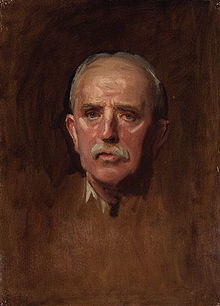John French, 1st Earl of Ypres - Picture
More about World War 1

|
|
John French, 1st Earl of Ypres
Place of birth: Ripple, Kent, England
Place of death: Deal Castle, Kent,England
Allegiance: United Kingdom
Service/branch: British Army
Years of service: 1866- 1921
Rank: Field-Marshal (1913)
Battles/wars: Mahdist War
Second Boer War
World War I
Anglo-Irish War
Awards: KCB (1900), KCMG (1902), GCVO (1905), GCB (1909), ADC (1911), OM (1914), KP (1917), PC (1918)
Field Marshal John Denton Pinkstone French, 1st Earl of Ypres KP, GCB, OM, GCVO, KCMG, ADC, PC (28 September 1852 - 22 May 1925), known as The Viscount French between 1916 and 1922, was a British and Anglo-Irish officer serving as the first Commander-in-Chief of the British Expeditionary Force (BEF) in World War I.
Early life
John French was born in Ripple in Kent (where he is also buried), the son of Commander John French, an officer in the Royal Navy. His father died in 1854 and soon his fragile mother was confined to a mental home. In 1863 the family moved to London.
His sister was the suffragette and Sinn Féin member Charlotte Despard. She would remain highly critical of her brother throughout his career.
He joined the Navy in 1866. He attended the Eastman’s Naval Academy in Portsmouth. In 1869 he served as a midshipman on HMS Warrior where it was discovered that he was acrophobic. He transferred to the British Army as a lieutenant in the 8th (King's Royal Irish) Hussars in 1874.
Career

Picture - Major-General Sir J.D.P. French around the time of the Siege of Kimberley
French took part in the Sudan expedition 1884-1885 and then received quick promotion. He commanded the 19th Hussars in 1889-1893 and then was made Assistant Adjutant-General 1893-1897. In 1897, he received command of the 2nd Cavalry Brigade which he exchanged two years later for the 1st Cavalry Brigade with which he took part in the Second Boer War 1899-1902, notably commanding the troops that relieved the Siege of Kimberley. He featured prominently too in the subsequent Battle of Paardeberg.
After the war, he was Commander-in-Chief for Aldershot Command 1901-1907 after which tenure he was promoted to full general and made Inspector-General of the Army (1907-1912). In 1911 he was made an ADC General to H.M. the King.
From March 1912 to April 1914, he served as Chief of the Imperial General Staff but resigned following the Curragh Mutiny and was made again Inspector-General of the Army in which post he served at the outbreak of World War I.
World War I
French was the natural choice as Commander-in-Chief of the British Expeditionary Force (BEF) in August 1914.
A man of hot temper, he argued with the Cabinet against Field-Marshal Lord Kitchener and General Sir Douglas Haig that the BEF should be deployed in Belgium, rather than Amiens, where both Haig and Kitchener believed it would be well placed to deliver a vigorous counter attack once the route of German advance was known. Kitchener argued that the placement of the BEF at Mons would result in having to abandon its position and much of its supplies almost immediately as the Belgian Army would be unable to hold its ground versus the Germans; given the solid belief in fortresses at the time, it is not surprising that French and the British cabinet disagreed with Kitchener on this issue.

Picture - General French (left) in Paris
After the BEF's first battles at Mons and Le Cateau, where, as Kitchener predicted, it had to retreat from its position to avoid the danger of being flanked when the Belgian position failed, French was increasingly indecisive and more concerned with preserving his troops, even suggesting removing them to the Channel Ports, than aiding the French. He began a tentative withdrawal which threatened to break the line between French and Belgian armies and needed an unwanted emergency meeting with Kitchener on 2 September 1914 to re-organise his thinking and direct the counter-offensive at the First Battle of the Marne. French was particularly upset by the fact that Kitchener arrived wearing his field marshal's uniform; he felt Kitchener was implying that he was French's superior and not simply a cabinet member, a fact he mentioned in a letter to Sir Winston Churchill. No one knows exactly what was said during the meeting, as neither man kept any record, but French became increasingly antagonistic towards Kitchener in the following months.
During the First Battle of Mons, French issued a series of hasty orders to abandon positions and equipment which were ignored by his sub-ordinate in charge of the II Corps of the BEF, General Sir Horace Smith-Dorrien. Smith-Dorrien instead mounted a vigorous defensive action, relieving the pressure and allowing the troops to re-organise, gather up their supplies and make a comfortable fighting withdrawal. Smith-Dorrien also ignored other orders from French which he considered to be unrealistic. Smith-Dorrien was removed from command after advocating a tactical withdrawal away from German lines at Ypres, following the first use of poison gas by German troops. Several days after this, French accepted the advice of General Plumer to perform a withdrawal almost identical to the one Smith-Dorrien had recommended.
French remained in command as major trenching began and oversaw the fighting at Neuve Chapelle and Ypres that finally destroyed the last of the original BEF. In 1915, he declined to co-operate with the French and after the failures at Aubers Ridge and, at Loos, the British offensive operations were almost halted. In December 1915, he was replaced by General Sir Douglas Haig.
French returned to England to be appointed Commander-in-Chief of the British Home Forces in December 1915 and oversaw the suppression of the Irish uprising in 1916. In January 1916, he was created Viscount French, of Ypres and of High Lake in the County of Roscommon.
At the beginning of the First World War a supporter of French, A.C. Ainger tried, with little success, to popularize a marching song in honour of French. The words read "Do you ken John French with his khaki suit His belt and gaiters and stout brown boot Along with his guns and his horse and his foot On the road to Berlin in the morning."
Lord Lieutenant of Ireland

Picture - John French, 1st Earl of Ypres c1919 by John Singer Sargent
In May 1918, he was appointed British Viceroy, Lord Lieutenant of Ireland and Supreme Commander of the British Army in Ireland.
Ashtown ambush
On 19 December 1919, an Irish Republican Army unit which consisted of 11 volunteers, including Sex¡n Treacy, Seamus Robinson, Sex¡n Hogan, Paddy Daly (Leader), Joe Leonard, Martin Savage and Dan Breen, planned to assassinate Lord French, head of the Dublin Castle administration in Ireland. An ambush was organised as he returned from a private party which he had hosted the previous evening at his country residence in Frenchpark, County Roscommon.
The volunteers' intelligence operative had informed the unit that Lord French would be travelling in the second car of the armed convoy that comprised an outrider and three following cars which would bring Lord French from Ashtown railway station to the Vice-Regal Lodge in Phoenix Park, Dublin.
Events of the day
The IRA unit gathered at Fleming's Pub in Drumcondra and left in small groups to avoid raising suspicion as they cycled through Phibsboro and up the Cabra Road. They regrouped at Kelly's Public House (now called the Halfway House) in Ashtown. At approximately 11:40 a.m., as the train carrying Lord French pulled into the station, the unit left the pub and took up positions along the crossroads at Ashtown.
The plan was for Martin Savage, Tom Kehoe and Dan Breen to push a hay-cart halfway across the road and then, after the out-rider and the first car had passed, they would push it the rest of the way across the road, thereby completely blocking the path of the remaining vehicles. They had been informed that Lord French was to be in the second car and this car would be attacked with grenades (known as Mills Bombs at the time) and concentrated rifle fire.
As they pushed the hay-cart across the road their plan was almost foiled as a Royal Irish Constabulary (RIC) officer disturbed them, telling them to move on. One of IRA men lobbed a grenade at him, although it didn't explode it struck the police officer on the head, knocking him unconscious. The police officer was then dragged from the road and the attack went ahead as planned.
Lord French's car and the gun battle
When the convoy appeared minutes later, the IRA unit attacked the second car forcing it to swerve off the road. However, unknown to the unit, Lord French was travelling in the first car and managed to drive through the blockade. The occupants of the second car, part of Lord French's guard, returned fire. As the gun battle developed the third car arrived on the other side of the cart and began firing with rifles and machine-guns on the now exposed IRA fighters.
In the crossfire Dan Breen was shot in the leg and seconds later Savage fell mortally wounded after being hit by a bullet in the neck. He died in the arms of Dan Breen and his last words to Breen were "I'm done, but carry on....". Tom Kehoe and the wounded Dan Breen carried Savage's body from the road and back to Kelly’s Pub while the gunfight continued.
Two Dublin Metropolitan Police officers were also wounded in the gun battle. At this point the British military, including some wounded, began to withdraw from the scene and continued on towards Phoenix Park. Realising reinforcements would be on their way, the IRA unit then dispersed to safe houses in the Dublin area. Dan Breen was helped onto his bike by Paddy Daly who helped him to a safehouse in the Phibsboro' area, where he was attended to by the captain of the Dublin hurling team, Dr J.M. Ryan.
Later career
French was President of The Ypres League, a veterans society for those who served at the Ypres Salient. He retired from the military in April 1921, and in May 1922 he was elevated to the Earldom of Ypres. French died on 22 May 1925 aged 72.
Ranks
Midshipman (1868)
Lieutenant (1874)
Captain (October 1880)
Colonel (August 1895)
Brigadier-general (1897)
Major-general (1899)
Lieutenant-general (August 1902)
General (February 1907)
Field marshal (3 June 1913)
Controversy after death
In 1972 The ownership of French's war diaries was disputed following the bankruptcy of the 3rd Earl of Ypres.
Army Manoeuvres of 1913
Christmas truce
Gheluvelt Park - a public park in Worcester which he opened on 17 June 1922
Saint George's Memorial Church, Ypres
Further reading
Books by French
Report of General Sir John French upon his inspection of the Canadian Military Forces (Ottawa, 1910)
The despatches of Sir John French: I Mons, II the Marne, III The Aisne, IV Flanders (Chapman & Hall, London, 1914)
The despatches of Lord French...And a complete list of the officers and men mentioned (Chapman & Hall, London, 1917)
The German and small nations: an interview with Lord French (J J Keliher & Co, London, 1917)
1914 (Constable & Co, London, 1919)
Some war diaries, addresses and correspondence, edited by Maj The Hon Edward Gerald French (son) (Herbert Jenkins, London, 1937)
Other books
Cassar, George H. The Tragedy of Sir John French (University of Delaware Press, 1985) ISBN 0-87413-241-X
Chisholm, Cecil Sir John French: an authentic biography (Herbert Jenkins, London, 1915) - also available from Project Gutenberg
Clark, Alan The Donkeys - a history of the BEF in 1915 Hutchison and Co, 1961. A scathing attack on the military competence, intelligence, and character of John French.
Dodsworth, Francis Major General J D P French (Soldiers of the Queen Library, London, 1900)
French, Edward Gerald (son) The Life of Field Marshal Sir John French, First Earl of Ypres (Cassell & Co, London, 1931)
French, Edward Gerald (son) French replies to Haig (Hutchinson & Co, London, 1936)
French, Edward Gerald (son) The Kitchener-French dispute: a last word (William Maclellan, Glasgow, 1960)
Goldman, Charles Sydney (1902). With General French and the cavalry in South Africa. London: Macmillan and co.. http://www.archive.org/details/withgeneralfren00goldgoog.
Holmes, Richard The Little Field Marshal: A Life of Sir John French Weidenfeld & Nicolson, 2004 ISBN 0-297-84614-0 - Well-received modern biography.
Jerrold, Walter Copeland Field Marshal Sir John French: the story of his life and battles (W A Hammond, London, 1915)
Maydon, John George French's Cavalry campaign in South Africa (C A Pearson, London, 1901)
Napier, Robert M Sir John French and Sir John Jellicoe: their lives and careers (Patriotic Publishing Co, London, 1914)
Rae, Archibald General French and Admiral Jellicoe (Collins, London, 1914)
Tuchman, Barbara, The Guns of August, (Random House, 1962) a history of the first month of World War I, Sir French is depicted as being incompetent, in a panic and in continual retreat.
Wallace, Richard Horatio Edgar Field Marshal Sir John French and his campaign (George Newnes, London, 1914)
Wallace, Richard Horatio Edgar The standard history of the war, comprising the official despatches from General French and staff, with descriptive narrative (four volumes, George Newnes, London, 1914-1915)
French in popular culture
Field Marshal French was played by Laurence Olivier in Richard Attenborough's World War I satire film Oh! What A Lovely War (1969).
More aircraft.
Source: WikiPedia